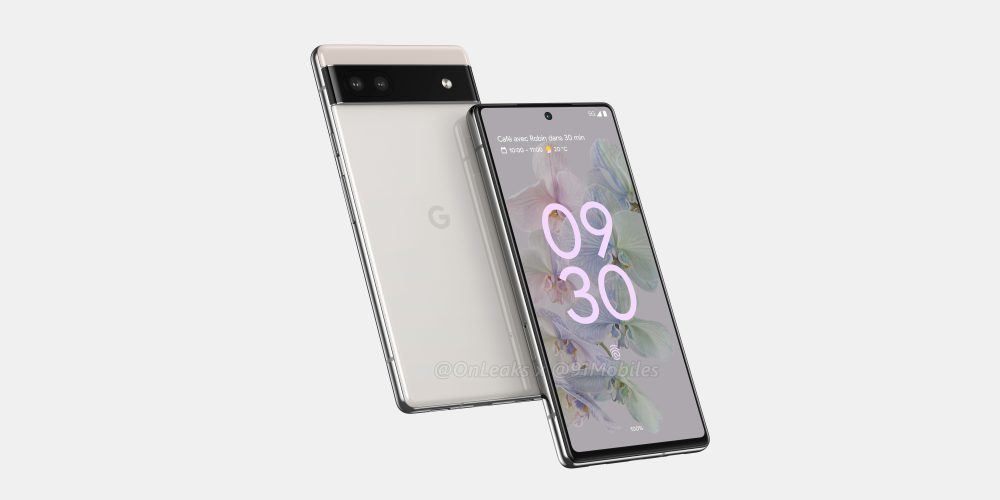
Following the launch of the Pixel 6 series, many have begun looking to Google’s next mid-range phone, the presumed “Pixel 6a.” We’ve uncovered the first specs for the Pixel 6a, including its Google Tensor chip and how the cameras will be a downgrade from the Pixel 6.
Google has offered a mid-range Pixel phone for about three years now. With the Pixel 3a in 2019, Google made their flagship camera – and more importantly the software – available in an affordable package. Pixel 4a carried on that camera, while also making the next-generation Google Assistant more accessible.
The Pixel 4a 5G stands out as an oddball, releasing as a lesser counterpart to the Pixel 5. And most recently, the Pixel 5a was the first to offer higher quality materials instead of plastic, along with water resistance.
Thanks to recently leaked renders, we’ve already gotten our first taste of what the Pixel 6a has in store, at least visually. Google’s mid-range phone for 2022 is set to carry on the rear camera bar or “visor” design of the Pixel 6 and Pixel 6 Pro, while also being the first A-series Pixel to not offer a 3.5mm headphone port.
Considering the rear camera bar’s design is essentially the same, one might assume that the upcoming Pixel 6a would offer the same 50-megapixel Samsung GN1 sensor for its main camera. This would follow the tradition of the Pixel A-series thus far.
However, according to information uncovered by our APK Insight team within the Google Camera app, the Pixel 6a – internally codenamed Bluejay – will have a 12.2-megapixel Sony IMX363 primary sensor. This is the same camera sensor that is found in every Google phone from the Pixel 3 through the Pixel 5a.
Beyond the simple decrease to the megapixel count, the GN1 on the Pixel 6 is physically larger than the IMX363, allowing it to capture more light and, therefore, more detail. While much of Google’s photography prowess comes from compensating with machine learning (things like Super Res Zoom), the larger sensor on the Pixel 6 was a significant contributor to the phone’s camera improvements.

Moving on, the rear camera bar will also contain a 12-megapixel IMX386 sensor. Judging from how the Pixel 6 uses this same sensor, it will likely serve as the ultrawide camera on the Pixel 6a. Similarly, the Pixel 6a’s selfies will be handled by the same 8-megapixel IMX355 as the smaller Pixel 6.
So to recap, the mid-range Pixel 6a appears to be equipped with three cameras:
- 12.2-megapixel IMX363 primary
- 12-megapixel IMX386 ultrawide
- 8-megapixel IMX355 front-facing
While only one of the three cameras has changed, this will certainly make for a fairly significant downgrade from the Pixel 6 down to the Pixel 6a. On the plus side, we’ve been able to discover elsewhere that the Pixel 6a will have the same Google Tensor GS101 chip as the Pixel 6.
This is only fitting, given how much excitement Google built around the Tensor chip during the Pixel 6’s launch event. Based on the chip’s inclusion, we believe that the Pixel 6a will likely offer the same Tensor-powered features of its flagship counterpart – features like Google Assistant voice typing, Live HDR, and on-device translations.
What remains to be seen is how Google intends to market this phone. The Pixel 4a was the perfect “palate-cleansing” small phone, while the Pixel 5a doubled down on battery life. It’s not yet known what role the Pixel 6a is intended to play in the broader Pixel lineup, but it’s clear that Google Tensor is the centerpiece of the company’s vision.
Dylan Roussel contributed to this article
Thanks to JEB Decompiler, from which some APK Insight teardowns benefit.
More on Google Pixel:
- Now Playing on Pixel readying redesign that adds ability to favorite songs
- Pixel 5a down to $349 as part of Google Fi Black Friday sale
- Pixel 6 preps big ‘At a Glance’ upgrade that shows BT device battery, doorbell & ‘flashlight is on’ alerts, more
Author: Kyle Bradshaw
Source: 9TO5Google



